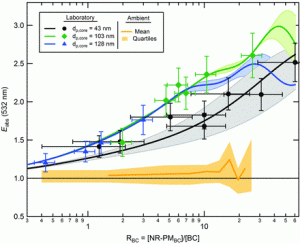Ibraheem Nuaaman, Phd, candidate, is co-author on a science paper, published in Science, Aug, 31, 2012, Vol. 337, no. 6098 pp. 1078-1081 - DOI: 10.1126/science. 1223447.

Abstract: Atmospheric black carbon (BC) warms Earth’s climate, and its reduction has been targeted for near-term climate change mitigation. Models that include forcing by BC assume internal mixing with non-BC aerosol components that enhance BC absorption, often by a factor of ~2; such model estimates have yet to be clearly validated through atmospheric observations. Here, direct in situ measurements of BC absorption enhancements (Eabs) and mixing state are reported for two California regions. The observed Eabs is small—6% on average at 532 nm—and increases weakly with photochemical aging. The Eabs is less than predicted from observationally constrained theoretical calculations, suggesting that many climate models may overestimate warming by BC. These ambient observations stand in contrast to laboratory measurements that show substantial Eabs for BC are possible.
August 29, 2012
